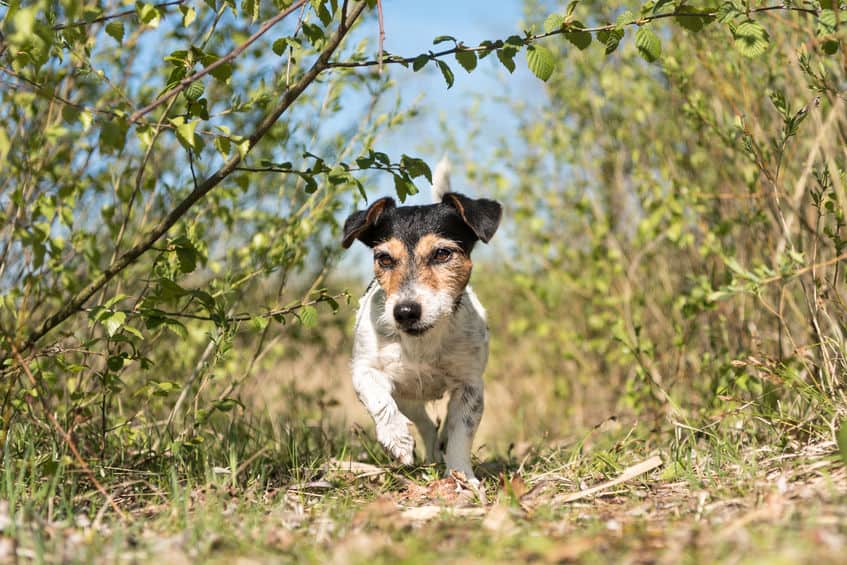Dogs enjoy exploring the outdoors, but what happens when your dog curiously delves into a bush or tree full of wasps? When agitated, wasps can target an unsuspecting victim, such as your dog, and leave behind a numbing, burning, or stinging sensation.
When a wasp stings a dog, it can cause swelling, discomfort, and an allergic reaction. Many wasp stings in dogs happen around the snout because dogs explore new areas through their sense of smell.
You can take steps to better safeguard your dog from wasps, including how to identify when your dog has been stung by a wasp and treating the affected area.
Why Are Dogs Drawn to Wasps?
Dogs are attracted to wasps out of sheer curiosity, for the same reason they’re eager to chase down a squirrel, pull towards a neighborhood cat, or run into a flock of grounded birds. Dogs find pleasure in engaging with other creatures, and wasps are no different. When a wasp does become annoyed or feel threatened by your dog’s persistent attempts, the wasp can then attack and sting your dog, occasionally resulting in an allergic reaction.

Proactive Plan
Having a proactive plan in place, such as working with your dog to ignore wasps, learning what wasp stings look like, and how to treat wasp stings if they do occur, can ensure your dog has safe and healthy encounters when playing outside.
Health Concerns
Wasps can ignite a similar allergic reaction in dogs as they do in humans. Wasps can sting any part of a dog’s body, but when a dog is exploring with its nose, this tends to be the most common location where a wasp will target first. Wasps often sting areas where fur is lighter because they can reach the skin easier. However, if your dog has a thinner coat, then a wasp sting can occur on any area of its body.
Reducing Contact
The best way to discourage interactions between your dog and wasps is to scale down the number of wasps congregating around your home. There are sprays available to deter wasps from outdoor areas for efficient pest control. If a wasp’s nest already exists, you may need to consider professional pest control to remove the nest safely and avoid angering the wasps further.
If You Notice Your Dog Pestering Wasps
While you can control the wasp problem around your home, you can’t always do the same at the dog park or on walks. When you notice your dog interacting with wasps on a dog walk, redirect your dog away from the wasp to prevent engaging further.
You can also train your dog with basic commands to ignore the wasp or focus on other surroundings instead, such as “Leave it!” This command will encourage your dog to avoid provoking a wasp. Not only will this keep you and your dog safe from a wasp’s sting, but it’ll keep the wasp happy too.
Treating Wasp Stings in Dogs
If your furry companion has been stung by a wasp, you may be able to treat less severe reactions at home. However, you’ll need to be able to distinguish wasp stings and any subsequent allergic reactions from other outdoor injuries (such as digging into thorn bushes), along with the discomfort that usually comes with them.
The first sign of a wasp sting is inflammation and swelling in and around the sting location. Start by checking areas where your dog’s fur is less dense, such as the snout, inside the ears, the stomach, or behind the tail.
Wasp stings are usually localized, so if you notice a series of bumps or spots, this could indicate another form of irritation, such as fleas.
React Quickly
By reacting quickly to your dog’s wasp sting, you can then tackle the problem efficiently and likely before needing any veterinary help. Research suggests that reactions to wasp stings occur within a half-hour of the initial sting, so it’s essential to keep a close watch on your dog if you suspect he’s come in contact with a wasp.
At-Home Care
To treat your dog at home for a wasp sting, you can use some simple DIY solutions that minimize swelling and reduce redness. Using cold water, an ice pack, and dog-safe anti-itch creams can alleviate discomfort and irritation. Your dog mustn’t scratch the area or agitate more, as this could lead to more discomfort and cause extended swelling, bleeding, and potential infections.
When To Head to the Vet
If at-home treatments aren’t doing the job, it could be time for a trip to the vet. The vet can assist with severe allergic reactions and administer quick-acting medications that can relieve a wasp sting’s potential side effects. The veterinary experts at VCA Hospitals recommend bringing your dog in as soon as possible if he shows signs of any of the following side effects:
- Ongoing swelling that doesn’t seem to subside.
- A breakout of hives or itchy rashes around the sting site or on the body.
- Trouble breathing, sleeping, or sounds as though they are wheezing.
- Vomiting, diarrhea, or uncontrollable drooling.
- Seizures and any other forms of twitching, dizziness, or disorientation.
After treatment, the vet will advise you to monitor your dog’s activity and health closely for the next few days to ensure irritation from the sting subsides. Your dog has no adverse side effects from the medications.
Conclusion
Wasps can often sting dogs as a reaction to your dog’s curiosity and eagerness to engage with them. While not all dogs react the same to wasp stings, it’s essential to be prepared with the right knowledge and tools to diminish your dog’s interactions with wasps and how to adequately treat your dog if he has been stung by a wasp.
Working with your dog and creating a proactive safety plan can reduce the adverse side effects that occur when wasps do sting dogs.
